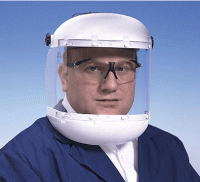Enhancing Workplace Safety a Necessity (Part Two)

- Eye and face protection: Flying objects, chemicals, dust, and vapors —all create the need for safety glasses, goggles, and face shields. Regular prescription glasses are typically not adequate protection.
- Head protection: Serious head injuries result from explosions, falls, and other traumatic events. OSHA states hard hats can protect workers "from impact and penetration hazards as well as from electrical shock and burn hazards." Ensure hard hats fit effectively and offer shock-absorbing features.
- Hand (and arm) protection: When cuts from sharp objects or harmful substances can penetrate the skin, hand and arm coverage is needed. Burns, cuts, and abrasions can be avoided with the correct safety gloves. Options range from temperature-resistant gloves to finger cots.
- Respiratory protection: Airborne particles, gas, and chemicals can infiltrate and irritate the lungs. To select, determine the level of particulate removal or filtration efficiency needed. Gas mask respirators, respirator hoods, full-face respirators, half-mask respirators, and safety face masks are among your choices.
- Hearing protection: To preserve hearing in environments containing excessive noise, wear hearing protectors. Look for noise reduction rating (NRR) and compliance level.
- Foot protection: Working with heavy or sharp objects, electrical hazards, or extreme temperatures requires safety footwear to prevent impact. Special-purpose shoes address specific electrical or temperature dangers.
- Body protection: Exposed areas of the body are vulnerable to hot splashes or external impact. From lab coats to coveralls to aprons, protective clothing is available. Look for fire resistance and special fabrics to safeguard you from chemical and physical threats.
Hazard assessments reveal which PPE is needed. Still:
- Each item must be fitted properly, worn regularly, and inspected for signs of wear or the need for replacement.
- Training programs to educate workers on the appropriate use and care of PPE are a necessity. OSHA also recommends habitually evaluating and updating training to maximize efficacy.
While eliminating hazards may be best, it may not always be possible. When processes themselves cannot remove the hazard, minimizing exposure to injury—and continually enhancing safety practices—protects workers.

Comentarios
Publicar un comentario